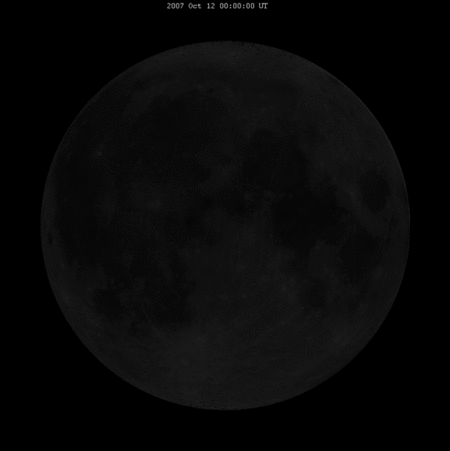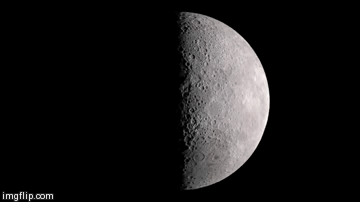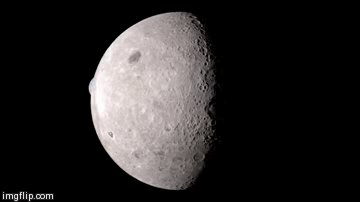“When I look at the moon I do not see a hostile, empty world. I see the radiant body where man has taken his first steps into a frontier that will never end.” -David Scott, Commander, Apollo 15
The Moon is perhaps the oldest sight known to humans and our animal ancestors here on Earth, with its features mostly unchanged for billions of years. Have a listen to Camera Obscura sing their soothing song,
while you consider that for nearly all of human history, we were only able to see just barely over 50% of the Moon.
 Image credit: Wikimedia Commons user Tomruen, viahttp://en.wikipedia.org/wiki/File:Lunar_libration_with_phase_Oct_2007_4….
Image credit: Wikimedia Commons user Tomruen, viahttp://en.wikipedia.org/wiki/File:Lunar_libration_with_phase_Oct_2007_4….
It was only in 1959 that we first glimpsed the far side of the Moon, by leaving Earth and flying behind it, to the far side of the lunar surface. Most recently, the Lunar Reconnaissance Orbiter has mapped the full sphere of the Moon to unprecedented accuracy, and NASA's Goddard Space Flight Center has responded by creating an animation of what "lunar libration" would look like -- and how it would affect the view of the Earth -- as seen from above the far side of the Moon!
 Images credit: NASA / GSFC, created at https://imgflip.com/gifgenerator.
Images credit: NASA / GSFC, created at https://imgflip.com/gifgenerator.
 Image credit: NASA / GSFC, created at https://imgflip.com/gifgenerator.
Image credit: NASA / GSFC, created at https://imgflip.com/gifgenerator.
Unbelievable! You've got to check the whole thing out.

So DSCOVR is going to be at the "L1 Lagrange Point ... 1.5 million kilometers (932,000 miles) sunward from Earth."
and
"The average distance to the Moon is 384403 km (238,857 miles)"
So -- anyone know the quality of the camera on DSCOVR? Field of view? How often will we see Earth and Moon in that field of view?
Supposedly it'll be a live stream -- but where will it appear?
Answering my own question, from the NASA webcast:
The pictures will be stored on the satellite, and downloaded once per day. They will be placed on a publicly accessible NASA website and be available the following day.
So, not live, and probably not video, and not high resolution.
The origins of DSCOVR date back to 1998, when the mission (then called Triana) was spearheaded by then-Vice President Al Gore to beam live views of the Earth from space ....
"DSCOVR will also fulfill part of its initial design by .... beaming back a steady stream of images of our home planet from space. The spacecraft should take a photo of Earth ever two hours, with the images expected to be available to scientists and the next day. "They'll be posted on a website for the public to see"
http://www.space.com/28486-spacex-rocket-landing-dscovr-launch-webcast…
So, no movies of the Moon moving around the Earth, no movies of the Earth turning.
Not quite a lobotomy, but sure a letdown.
so -- forgive the digression? Is any other blogger talking about DSCOVR somewhere? If so I haven't found it.
And I'm real curious to know if that NASA animation will resemble what DSCOVR will be seeing when the Moon is on the sunward side of Earth. DSCOVR at L1 is about 4x the distance of the Moon from Earth, so .... it'll depend on the focal length of the camera lens how much we see.
Hello? ... is this thing working? ....
Well, nobody. So, I'm a cuckoo blogger, laying my eggs in other people's nests. Thanks for tolerating it.
Angle of view: http://www.spaceflight101.com/uploads/6/4/0/6/6406961/2373710.png?570 (EPIC is the camera)
"Radiometric stability of the EPIC instrument will be assessed by regular analysis of ice-covered surfaces of Earth and dedicated imaging of the Moon’s sunlit face at a nearly constant phase angle when it is at its furthest distance from L1." which would be almost behind the Earth as on that linked picture. So yes, it will, barely, see the Moon passing the Earth.
Oh, and
" In theory, EPIC achieves a ground resolution of 8 Kilometers per pixel, but due to optical distortion along the field of view, the actual resolution in the image center will be around ten Kilometers while the ground resolution on the edges will be 14 Kilometers. Most images will be downlinked after going through onboard processing that reduces data volume resulting in a reduction in ground resolution to 25 Kilometers...."
http://www.spaceflight101.com/dscovr.html
hm, this www thing seems to be obsolete, I had to go to Twitter to find this, apparently from somewhere at NASA, showing, yes, the back side of the Moon and the full Earth as DSCOVR should see them:
https://pbs.twimg.com/media/B-ThXQsIEAAMXKl.jpg
and more at a web page named
http://dscovr.space/